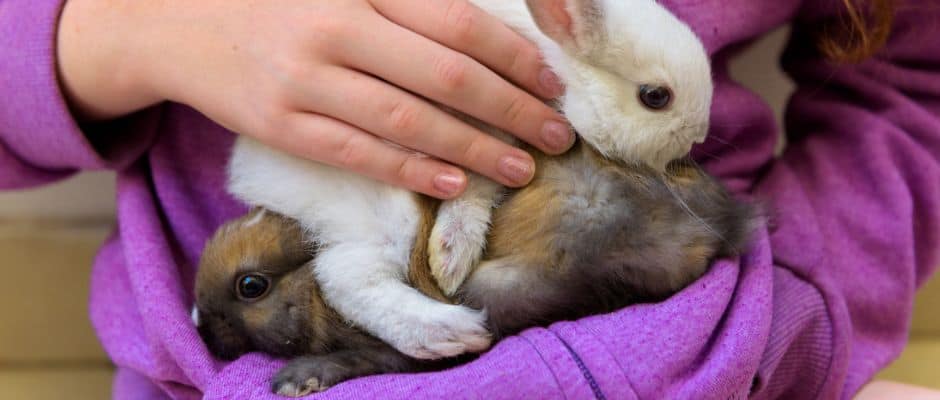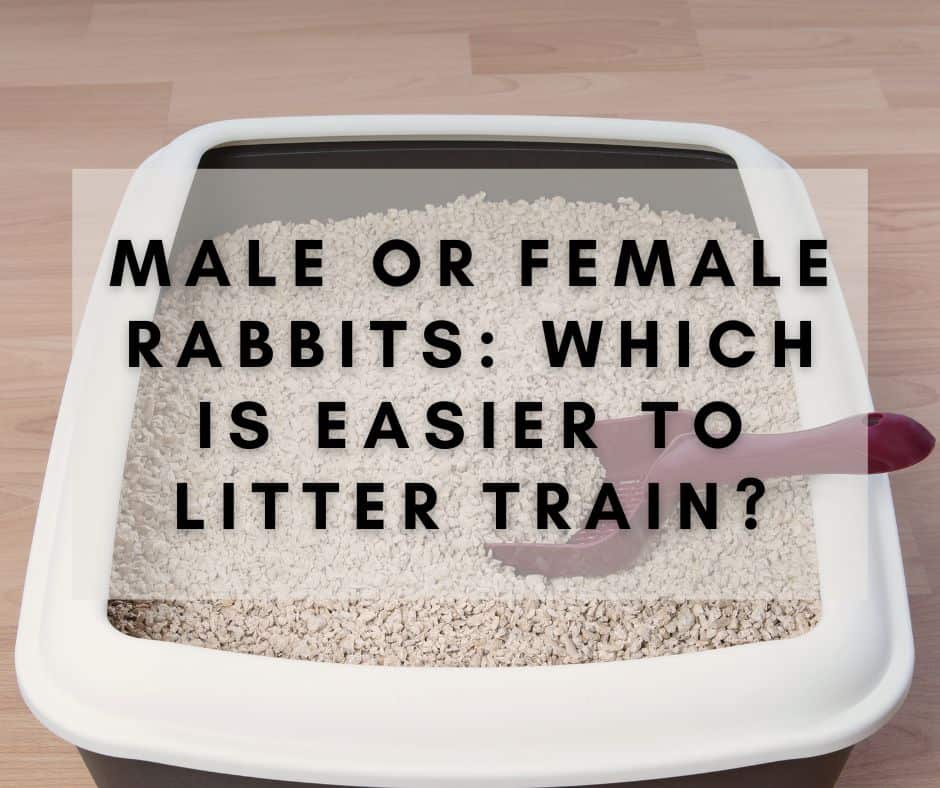As a rabbit owner, I am often asked whether male or female rabbits are easier to litter train. It’s a valid question, as litter training is an important part of living with a rabbit, and it can be a frustrating experience for new rabbit owners. The truth is, the ease of litter training a rabbit has less to do with their gender and more to do with their individual personality and behavior.
As a matter of fact, both male and female rabbits can be successfully litter trained with patience, consistency, and positive reinforcement. However, there are some differences in behavior between male and female rabbits that could impact litter training.
For example, male rabbits may be more territorial and prone to marking their territory with urine, which can make litter training a bit more challenging. On the other hand, female rabbits may be more fastidious and prefer to keep their living area clean, making them easier to litter train. But again, these are generalizations, and every rabbit is unique.
Before we dive into the specifics of litter training male and female rabbits, it’s important to understand the basics of litter training and the different types of litter available. With a little knowledge and a lot of patience, you can successfully litter train any rabbit, regardless of their gender.
Contents
Male vs Female Rabbits
Behavioral Differences
When it comes to litter training, there are some behavioral differences between male and female rabbits to consider. Male rabbits tend to be more territorial and may mark their territory more frequently. This behavior can make litter training more challenging, as they may be more likely to urinate outside of their designated litter box.
Female rabbits, on the other hand, tend to be more fastidious and may be easier to litter train. They are less likely to mark their territory and are generally more clean and organized in their living spaces.
It’s important to note, however, that individual rabbits may vary in their behavior and personality, regardless of gender. Some male rabbits may be easy to litter train, while some female rabbits may be more difficult.
In addition to gender, other factors that can affect litter training include the rabbit’s age, health, and environment. Providing a spacious and clean living space, as well as consistent and positive reinforcement during litter training, can help increase the likelihood of success.
Overall, while male rabbits may present some challenges when it comes to litter training, it’s important to approach each rabbit as an individual and work with their unique personality and behavior to achieve success.

Litter Training Basics
Litter training a rabbit can be a straightforward process if done correctly. Here are some basics to keep in mind:
Training Tips
When training a rabbit to use a litter box, it is important to keep the litter box in the same place consistently. Rabbits are creatures of habit, and they will be more likely to use the litter box if it is always in the same location. Additionally, it is helpful to keep the litter box clean and free of any waste. Rabbits are clean animals and will avoid using a dirty litter box.
Rewards
Positive reinforcement is key when litter training a rabbit. Offering treats or verbal praise when the rabbit uses the litter box can help reinforce good behavior. However, it is important to avoid overfeeding the rabbit with treats, as this can lead to weight gain and health problems.
Consistency
Consistency is the key to success when litter training a rabbit. It is important to be patient and consistent with training, as rabbits may take some time to learn. If the rabbit has accidents outside of the litter box, it is important to clean the area thoroughly to remove any scent that may attract the rabbit back to that spot.
In conclusion, litter training a rabbit can be a simple process if done correctly. By keeping the litter box in the same location, offering positive reinforcement, and being consistent with training, rabbits can quickly learn to use the litter box.
Location and Litter Box Types
When it comes to litter training a rabbit, choosing the right location and litter box can make all the difference. Here are some important factors to consider:
Choosing the Right Litter Box
The size and shape of the litter box can greatly affect your rabbit’s willingness to use it. A litter box that is too small or cramped may cause your rabbit to avoid it altogether. A good rule of thumb is to choose a litter box that is at least twice the size of your rabbit.
In addition to size, the type of litter box you choose can also impact your rabbit’s litter training success. Some popular options include:
- Plastic litter boxes: These are lightweight and easy to clean, but may retain odors over time.
- Ceramic litter boxes: These are heavy and durable, but may crack or break if dropped.
- Corner litter boxes: These are designed to fit snugly into a corner, which can help save space in your home.
Ultimately, the best litter box for your rabbit will depend on their individual preferences and needs. It may take some trial and error to find the right fit.
Types of Litter
Choosing the right type of litter is just as important as choosing the right litter box. Here are some common options:
- Paper-based litter: Made from recycled paper, this type of litter is absorbent and easy to clean. It is also dust-free, making it a good choice for rabbits with respiratory issues.
- Wood-based litter: Made from sawdust or wood shavings, this type of litter is absorbent and has a natural scent that can help control odors. However, it can be dusty and may cause respiratory issues in some rabbits.
- Pelleted litter: Made from compressed sawdust or paper, this type of litter is highly absorbent and can be less messy than other options. However, it may be more difficult to find in stores.
It’s important to note that some rabbits may have allergies or sensitivities to certain types of litter. If you notice any signs of discomfort or irritation, it may be necessary to switch to a different type.
In summary, choosing the right location and litter box types can greatly improve your rabbit’s litter training success. By taking the time to find the right fit, you can help ensure a clean and comfortable living space for your furry friend.
Health Considerations
When litter-training rabbits, it is important to consider their overall health. Here are some health-related factors to keep in mind:
Spayed and Neutered Rabbits
Spaying or neutering your rabbit can have a significant impact on its litter training success. Unaltered rabbits tend to mark their territory more frequently and in more places, which can make litter training more challenging. Additionally, female rabbits that are not spayed have a higher risk of developing uterine cancer as they age, which can lead to urinary problems and other health issues.
Urinary Tract Infections
Urinary tract infections (UTIs) are a common health issue in rabbits, and they can make litter training more difficult. Signs of a UTI in rabbits include straining to urinate, blood in the urine, and frequent urination. If you suspect that your rabbit has a UTI, it is important to take them to a veterinarian for treatment as soon as possible.
To prevent UTIs, make sure that your rabbit has access to plenty of fresh water at all times, and clean their litter box frequently to minimize the risk of bacterial infections. Additionally, feeding your rabbit a diet that is high in fiber can help prevent urinary problems by promoting healthy digestion.
Overall, keeping your rabbit healthy and addressing any health issues promptly can help make litter training easier and more successful.
Pros and Cons of Litter Training
Litter training a rabbit can be a great way to keep your home clean and tidy. However, it’s important to consider both the pros and cons before deciding whether or not to litter train your rabbit.
Pros
- Cleanliness: Litter training your rabbit can help keep your home clean and odor-free. Rabbits tend to be very clean animals, and they will often naturally use one area of their cage as a bathroom.
- Convenience: Litter training can make it easier to clean your rabbit’s cage. Instead of having to clean the entire cage every day, you can simply clean the litter box.
- Bonding: Litter training can also help strengthen the bond between you and your rabbit. When you spend time with your rabbit while they’re using the litter box, they’ll associate you with positive experiences and may become more affectionate.
Cons
- Training time: Litter training can take time and patience. Some rabbits may take longer to learn than others, and accidents are bound to happen.
- Cost: Litter training may require additional supplies, such as litter boxes and litter. These costs can add up over time.
- Health concerns: Some types of litter can be harmful to rabbits if ingested. It’s important to choose a litter that is safe for your rabbit and to monitor them closely while they’re using the litter box.
Overall, litter training can be a great way to keep your home clean and bond with your rabbit. However, it’s important to consider the pros and cons before making a decision.
FAQs
Q: How long does it take to litter train a rabbit?
A: Litter training a rabbit can take anywhere from a few days to a few weeks. It depends on the rabbit’s age, temperament, and whether or not they have been litter trained before. Patience and consistency are key when litter training a rabbit.
Q: Should I use a litter box or a corner tray for my rabbit?
A: Both litter boxes and corner trays can be used for litter training a rabbit. However, corner trays are often preferred by rabbit owners because they take up less space and are easier to clean. Litter boxes with high sides can also be used to prevent litter from being kicked out of the box.
Q: What type of litter should I use for my rabbit?
A: The best type of litter to use for a rabbit is paper-based litter. Avoid using clay or clumping litter as these can be harmful if ingested by the rabbit. Pine and cedar shavings should also be avoided as they contain harmful oils that can irritate the rabbit’s respiratory system.
Q: Are male or female rabbits easier to litter train?
A: There is no significant difference in litter training between male and female rabbits. Both genders can be litter trained successfully with patience and consistency. However, it is important to note that intact rabbits (those who have not been spayed or neutered) may be more difficult to litter train due to hormonal changes that can affect their behavior.
Conclusion
In conclusion, both male and female rabbits can be litter trained with patience and consistency. It is important to keep in mind that rabbits are social animals and require affectionate care to thrive.
When it comes to litter training, the rabbit’s age, and previous experiences can play a role in their success. Younger rabbits may be easier to train as they are still learning their habits, while older rabbits may have established behaviors that are harder to break.
Mistakes can happen during the litter training process, but it is important to remain patient and consistent. Consistent positive reinforcement and rewards for good behavior can help encourage rabbits to use their litter box.
Overall, with the right care and attention, rabbits can make wonderful pets that are both affectionate and social.







